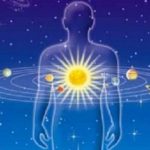Ayurveda, the Vedic wisdom of life tells us about five elements. Five principles of matter…

Those five cosmic principles are ether, air, fire, water, and earth. These five elements are not to be understood as the scientific elements. For example, ether has nothing to do with the chemical compound with the same name. Likewise, the element of water is not about oxygen and hydrogen atoms.
The five elements of Ayurvedic physics are related to ancient Vedic understanding of cosmology and energy.
These are the principles of the nature (Prakriti).
Prakriti refers to nature, it refers to the world of experience. Prusha refers to the realm of divinity, or transcendental consciousness. So everything in the world of experiences is a part of Prakriti and composed of these five principles. Every object, every living being, and every human being is composed of these five principles. What makes us all different is the composition amounts of these principles.
The five principles of water, fire, air, earth and ether in Ayurvedic understanding relates to energetic principles of those elements.
It has a rather physical energetic approach than a biological or chemical one. For example, the element of water is fluidity, liquidity, moist etc.. it is the fluids of our body like the blood, mucus etc…. We have all five elements in our bodies. Even if we do not have the chemical element earth in our bodies. We don’t have any soil in our bodies yes, but the element of earth is there. Our bones are filled with inertia, and solidity so the bones are saturated with the energy of the earth element.
Akasha is the Sanskrit name of the element ether.
Ether represents empty space in the absence of anything. It is not like a vacuum. Vacuum effect happens because there is air out of the vacuum. The ether is just space. According to Vedic cosmology, there was ether before the other elements. It is where everything happens. It is the medium where sound travels. It’s the medium where enrgy travels without any resistance.
In yoga tradition the sound and vibration is very important. Everything has a vibration. This also a scientific claim. The atomic particles vibrate. All physical beings, humans, animals, plants also objects are composed of the vibrating atomic particles. Sound also travels in waves; different sounds have different frequencies. So, the words have unique vibrations according to how they are uttered. Our emotional states and our intentions effects our voice.
The difference between the scientific attitude and the yogic wisdom is about the correlations between these vibrations. Scientific attitude examines these vibrations separately whereas in yoga tradition tells us that all these are related. Yogic wisdom tells us that vibrations of intentions and thoughts has the power to create realities. There is no such understanding of Ether in science. Ether is the space where everything comes together, where everything connects.
Ether is associated with the principle of pervasiveness in Ayurveda.
Vayu is the Sanskrit name of the air element.
Sometimes it is referred as the wind. The literal translation of the word is movement. Air is the second element that comes to being from ether.
First there was ether. Then the vibrations in the space give rise to the movement and so there was air. Vayu (air) represents the principle of movement in Ayurveda.
What properties would you associate with the element of air? What is the effect of air on other things? It moves, it makes things move even fly, it makes things dry. Wind clears up the air and also makes it cold. We can feel the wind with the sense of touch, we can also hear its sound. The energetic properties of this element are dry, cold, light, rough.
These are the principles of the nature (Prakriti).
Prakriti refers to nature, it refers to the world of experience. Prusha refers to the realm of divinity, or transcendental conzsciousness. So everything in the world of experiences is a part of Prakriti and composed of these five principles. Every object, every living being, and every human being is composed of these five principles. What makes us all different is the composition amounts of these principles.
The five principles of water, fire, air, earth and ether in Ayurvedic understanding relates to energetic principles of those elements.
It has a rather physical energetic approach than a biological or chemical one. For example, the element of water is fluidity, liquidity, moist etc.. it is the fluids of our body like the blood, mucus etc…. We have all five elements in our bodies. Even if we do not have the chemical element earth in our bodies. We don’t have any soil in our bodies yes, but the element of earth is there. Our bones are filled with inertia, and solidity so the bones are saturated with the energy of the earth element.
Akasha is the Sanskrit name of the element ether.
Ether represents empty space in the absence of anything. It is not like a vacuum. Vacuum effect happens because there is air out of the vacuum. The ether is just space. According to Vedic cosmology, there was ether before the other elements. It is where everything happens. It is the medium where sound travels. It’s the medium where enrgy travels without any resistance.
In yoga tradition the sound and vibration is very important. Everything has a vibration. This also a scientific claim. The atomic particles vibrate. All physical beings, humans, animals, plants also objects are composed of the vibrating atomic particles. Sound also travels in waves; different sounds have different frequencies. So, the words have unique vibrations according to how they are uttered. Our emotional states and our intentions effects our voice.
The difference between the scientific attitude and the yogic wisdom is about the correlations between these vibrations. Scientific attitude examines these vibrations separately whereas in yoga tradition tells us that all these are related. Yogic wisdom tells us that vibrations of intentions and thoughts has the power to create realities. There is no such understanding of Ether in science. Ether is the space where everything comes together, where everything connects.
Ether is associated with the principle of pervasiveness in Ayurveda.
Vayu is the Sanskrit name of the air element.
Sometimes it is referred as the wind. The literal translation of the word is movement. Air is the second element that comes to being from ether.
First there was ether. Then the vibrations in the space give rise to the movement and so there was air. Vayu (air) represents the principle of movement in Ayurveda.
What properties would you associate with the element of air? What is the effect of air on other things? It moves, it makes things move even fly, it makes things dry. Wind clears up the air and also makes it cold. We can feel the wind with the sense of touch, we can also hear its sound. The energetic properties of this element are dry, cold, light, rough.
The third element is fire.
The Sanskrit name of the element fire is Agni. From ether and air, fire comes into existence. The movements of air in ether creates friction and heat, so we get fire.
The main aspect of fire is transformation. When lit a candle it melts the candle burns the rope. When you cook a meal, its taste and its texture changes. When you burn incents you get the beautiful smelling vapour. Fire contains the energy of transformation. This is why in Ayurveda the power of digestion is called digestive fire. Digestion transforms food.
Fire element is associated with the principle of radience. This is the first visible element. So it is associated with the sense of sight.
The water element is called Jala or Ap in Sanskrit.
This is the foruth elements that comes into existence out of previous three elements. As the fire causes the air to get dense we get the element water. This is the first element that we can taste. Water element is associated with principle of cohesion. When you put something in water it wraps around. It also dilutes makes things less saturated or dissolves things.
Water element is associated with the sense of taste. Our bodily fluids, like the blood, synovial fluids in joints, are governed by the water element. Think about water. Which properties would you attribute to water? Obviously it is liquid. It also makes things slide (Yes, I am thinking about the water slides.), so it is oily in this sense. It has cooling and calming effect, so it is soft and cold. It is also slow in comparison to the previous elements especially.
Finally, the last element is the earth.
Prithivi is the Sanskrit name of the earth element. With addition of the cosmic dust to the mix
of other four elements we get the element earth.
This is the element that comes with the sense of smell. The sense of smell is closely associated with our survival issues.
Earth element is related with the principle of inertia. Inertia is the resistence to movement. Clearly this is the most dense element and the most stable one. In comparison to other four elements this is the hardest, heaviest element.
















































